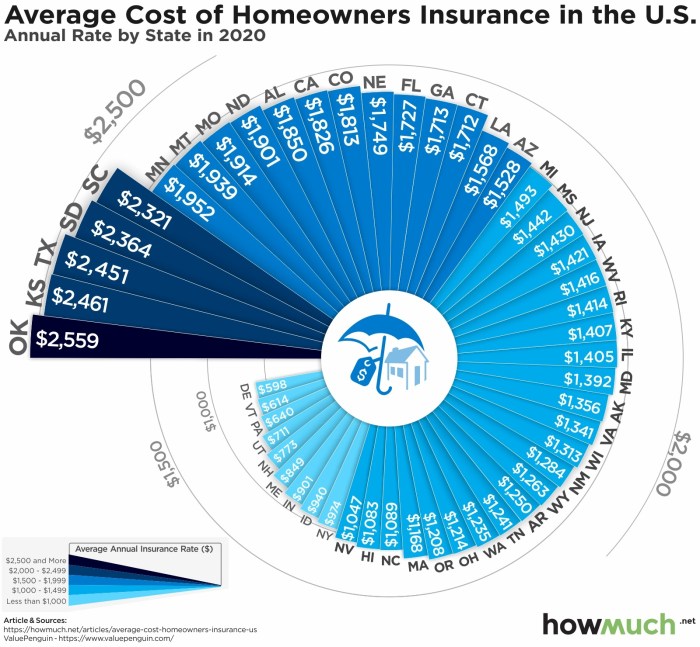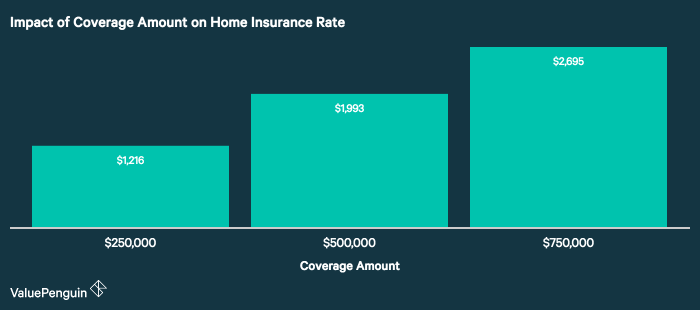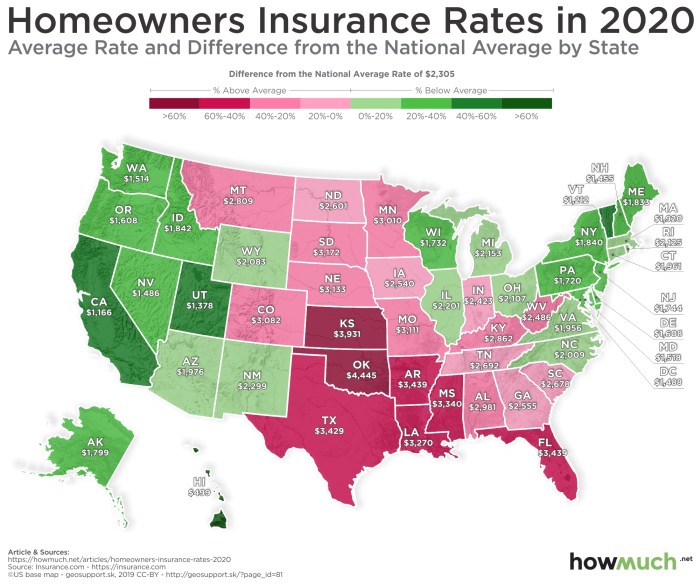Securing your home is a significant investment, and understanding the associated costs is crucial. Homeowner insurance premiums vary considerably, influenced by a complex interplay of factors. This guide delves into the intricacies of average homeowner insurance costs, providing a clear picture of what influences these expenses and how homeowners can navigate this landscape effectively. We’ll explore the key variables affecting premiums, discuss regional variations, and offer practical strategies for minimizing costs.
From the type of dwelling and its location to your credit score and claims history, numerous elements contribute to the final premium. We’ll examine each factor in detail, equipping you with the knowledge to make informed decisions about your coverage and budget. Ultimately, understanding your insurance costs allows you to protect your investment while maintaining financial prudence.
Factors Influencing Homeowner Insurance Costs
Understanding the factors that determine your homeowner’s insurance premium is crucial for budgeting and securing the best possible coverage. Several key elements contribute to the final cost, and being aware of these can help you make informed decisions about your policy. This information will provide a clearer picture of how insurers assess risk and set premiums.
Factors Affecting Homeowner Insurance Premiums
Several interconnected factors influence the cost of homeowner’s insurance. These factors are assessed by insurance companies to determine the level of risk associated with insuring a particular property and its owner. The following table provides a breakdown of these key elements.
| Factor | Impact on Premium | Explanation | Example |
|---|---|---|---|
| Location | High risk areas = higher premiums | Areas prone to natural disasters (hurricanes, earthquakes, wildfires) or high crime rates generally have higher premiums. | A home in a coastal area prone to hurricanes will typically have a higher premium than a similar home in an inland location. |
| Home Age and Condition | Older homes = potentially higher premiums | Older homes may require more maintenance and are potentially at higher risk for damage. The condition of the home’s systems (roof, plumbing, electrical) also plays a significant role. | A home with an outdated electrical system may have a higher premium than a home with a recently updated system. |
| Coverage Type and Amount | Higher coverage = higher premiums | The type and amount of coverage you choose directly impact your premium. More comprehensive coverage will generally cost more. | Choosing a higher dwelling coverage limit will result in a higher premium, but also provides greater financial protection in case of damage. |
| Credit Score | Good credit = lower premiums | Insurers often use credit scores as an indicator of risk. A higher credit score typically results in lower premiums. | Individuals with excellent credit scores may qualify for discounts, while those with poor credit may face higher premiums. |
Impact of Claims History on Insurance Costs
Your claims history significantly influences future insurance premiums. Filing claims, even for minor incidents, can lead to premium increases. The frequency and severity of claims are key factors considered by insurance companies.
The following illustrates various claim scenarios and their potential impact:
- Minor Claim (e.g., small hail damage): May result in a slight premium increase, or no increase if the insurer views it as a low-impact event.
- Significant Claim (e.g., major water damage): Will likely result in a substantial premium increase, potentially for several years.
- Multiple Claims within a Short Period: Can lead to significantly higher premiums or even policy cancellation.
- Fraudulent Claim: Will almost certainly result in policy cancellation and difficulty obtaining future insurance.
Insurance Costs for Different Home Types
The type of home you own also affects insurance costs. Single-family homes, condos, and townhomes carry different levels of risk and, therefore, different insurance premiums.
| Home Type | Typical Premium Range | Reasoning |
|---|---|---|
| Single-Family Home | Generally higher | More extensive coverage needed due to greater size and potential for damage. |
| Condominium | Generally lower | Shared responsibility for building maintenance and repairs reduces individual risk. |
| Townhome | Moderate | Falls between single-family and condo in terms of risk and coverage requirements. |
Coverage Types and Their Associated Costs

Understanding the different types of homeowner insurance coverage and their associated costs is crucial for securing adequate protection while managing your budget effectively. Choosing the right policy depends on your specific needs and the value of your property. Different policies offer varying levels of coverage and, consequently, different price points.
Homeowner insurance policies are categorized into several types, each designed to address specific needs and risks. The most common types are HO-3, HO-4, and HO-6. These policies offer different levels of protection for your dwelling, personal property, and liability. The cost of each policy varies based on several factors, including location, coverage limits, deductibles, and the insurer.
Homeowner Insurance Policy Types and Costs
| Policy Type | Description | Typical Cost Range (Annual) |
|---|---|---|
| HO-3 (Special Form) | Provides open-perils coverage for your dwelling (meaning it covers most perils unless specifically excluded) and named-perils coverage for your personal property. This is the most common type of homeowner’s insurance. | $1,000 – $3,000+ |
| HO-4 (Renters Insurance) | Covers your personal property against damage or theft, and provides liability coverage for accidents that occur in your rented dwelling. | $150 – $500+ |
| HO-6 (Condominium Insurance) | Covers your personal property and provides liability coverage. It typically covers improvements and alterations you’ve made to your condo unit, but not the building’s structure itself (that’s covered by the condo association’s master policy). | $200 – $800+ |
The cost ranges provided above are estimates and can vary significantly based on numerous factors. It is crucial to obtain quotes from multiple insurers to compare prices and coverage.
Coverage Limits and Deductibles
Coverage limits and deductibles significantly impact the overall cost of your homeowner’s insurance. Understanding these elements is essential for making informed decisions.
- Coverage Limits: These are the maximum amounts your insurer will pay for covered losses. Higher coverage limits generally result in higher premiums. For example, a higher coverage limit for dwelling coverage will protect you from larger losses but will increase your premium.
- Deductibles: This is the amount you pay out-of-pocket before your insurance coverage kicks in. A higher deductible typically leads to lower premiums, as you’re accepting more financial risk. A $1,000 deductible, for instance, means you pay the first $1,000 of any claim, while the insurer covers the rest.
- Impact on Cost: The interplay between coverage limits and deductibles directly affects your premium. A higher deductible with lower coverage limits will usually result in a lower premium, but leaves you more vulnerable to significant financial losses in case of a major event. Conversely, higher coverage limits and lower deductibles provide greater protection but come at a higher cost.
Cost-Effectiveness of Different Coverage Options
The most cost-effective homeowner’s insurance policy depends heavily on individual circumstances. Let’s consider a few scenarios:
- Scenario 1: A homeowner with a newly built, high-value home. In this case, a higher coverage limit and a lower deductible might be more cost-effective despite the higher premium, as the potential losses from damage are substantially higher. The peace of mind outweighs the higher cost.
- Scenario 2: A renter with limited possessions. For a renter, a basic renters insurance policy (HO-4) with a higher deductible is likely the most cost-effective option, providing sufficient protection against loss or damage to personal belongings without incurring excessive premiums.
- Scenario 3: A homeowner in a high-risk area (e.g., prone to hurricanes or wildfires). In such areas, insurance premiums are typically higher regardless of the policy type. While a higher deductible might lower the premium, it’s crucial to weigh the risk of catastrophic losses against the cost savings. A higher coverage limit might be necessary, even if it means a higher premium.
Understanding Your Policy and Finding the Best Rates

Securing the best homeowner insurance rate involves understanding your policy’s key elements and actively comparing quotes from multiple providers. This process requires careful consideration of your coverage needs and a proactive approach to negotiating favorable terms.
A thorough understanding of your homeowner’s insurance policy is crucial for protecting your financial interests. Failing to understand the specifics of your coverage could lead to inadequate protection and significant financial losses in the event of a covered incident.
Key Elements of a Standard Homeowner Insurance Policy
Several key elements within a standard homeowner’s insurance policy warrant careful review. Familiarizing yourself with these aspects ensures you have the appropriate coverage and understand your responsibilities as a policyholder.
- Coverage Amounts: This specifies the maximum amount the insurer will pay for covered losses, such as dwelling coverage (the structure of your home), personal property coverage (your belongings), and liability coverage (protection against lawsuits). Understanding these limits is vital to ensure adequate protection for your assets.
- Deductibles: This is the amount you pay out-of-pocket before your insurance coverage kicks in. Higher deductibles generally result in lower premiums, but you’ll pay more in the event of a claim. Choosing the right deductible involves balancing cost savings with your risk tolerance.
- Exclusions: These are specific events or damages that are not covered by your policy. Common exclusions include flood damage (requiring separate flood insurance), earthquakes, and intentional acts. Knowing these exclusions prevents unexpected financial burdens.
- Premium Calculation: The premium, or the cost of your insurance, is determined by several factors including your home’s location, age, construction, and the coverage amounts you select. Understanding how these factors influence your premium allows for informed decision-making.
Obtaining and Comparing Quotes from Multiple Insurance Providers
Shopping around for homeowner’s insurance is essential to securing the best rate. A systematic approach to obtaining and comparing quotes simplifies the process and increases your chances of finding a favorable policy.
- Identify Potential Providers: Research various insurance companies operating in your area, considering both large national insurers and smaller regional companies. Online comparison tools can be helpful in this initial stage.
- Gather Necessary Information: Before requesting quotes, compile all relevant information about your property, including its address, square footage, age, construction materials, and any recent renovations. Accurate information ensures accurate quote generation.
- Request Quotes: Contact multiple insurers, either online or by phone, and request detailed quotes. Be sure to specify the coverage amounts and deductibles you are considering.
- Compare Quotes: Carefully review each quote, paying close attention to the coverage amounts, deductibles, premiums, and any exclusions. Don’t solely focus on the premium; consider the overall value and comprehensiveness of the coverage offered.
- Select the Best Policy: Based on your comparison, choose the policy that best meets your needs and budget. Consider factors beyond price, such as the insurer’s reputation for claims handling and customer service.
Tips for Communicating with Insurance Providers and Negotiating Better Rates
Effective communication and negotiation can significantly impact your homeowner’s insurance costs. Proactive engagement with insurers can lead to more favorable terms.
- Be Prepared: Before contacting an insurer, gather all relevant information about your property and coverage needs. This demonstrates preparedness and facilitates a more efficient conversation.
- Ask Clarifying Questions: Don’t hesitate to ask questions about any aspects of the policy you don’t understand. A clear understanding is crucial for making informed decisions.
- Negotiate Deductibles and Coverage: Explore the possibility of adjusting your deductible or coverage amounts to find a balance between premium cost and risk protection. Higher deductibles often lead to lower premiums.
- Bundle Policies: Consider bundling your homeowner’s insurance with other policies, such as auto insurance, to potentially receive discounts. Many insurers offer bundled policy discounts.
- Explore Discounts: Inquire about potential discounts, such as those for security systems, fire-resistant roofing materials, or claims-free history. These discounts can significantly reduce your premium.
Final Review

Navigating the world of homeowner insurance can seem daunting, but with a thorough understanding of the influencing factors and available strategies, homeowners can effectively manage their premiums. By carefully considering coverage types, location, and personal risk factors, you can secure adequate protection while optimizing your costs. Remember to shop around, compare quotes, and maintain open communication with your insurer to ensure you receive the best possible value for your investment in home protection.
Question & Answer Hub
What is the difference between HO-3, HO-4, and HO-6 insurance policies?
HO-3 (Special Form) is the most common, covering damage to your home and belongings. HO-4 (Renters) covers personal belongings in a rental. HO-6 (Condominium) covers your unit and personal belongings.
How does my credit score affect my insurance premiums?
Insurers often use credit scores as an indicator of risk. A higher credit score typically translates to lower premiums.
Can I lower my premiums by making home improvements?
Yes, improvements like security systems, smoke detectors, and impact-resistant windows can often lead to discounts.
What is a deductible, and how does it impact my costs?
A deductible is the amount you pay out-of-pocket before your insurance coverage kicks in. A higher deductible typically results in lower premiums.
How often should I review my homeowner’s insurance policy?
It’s advisable to review your policy annually to ensure it still meets your needs and that you’re getting the best rate. Life circumstances change, and so should your coverage sometimes.